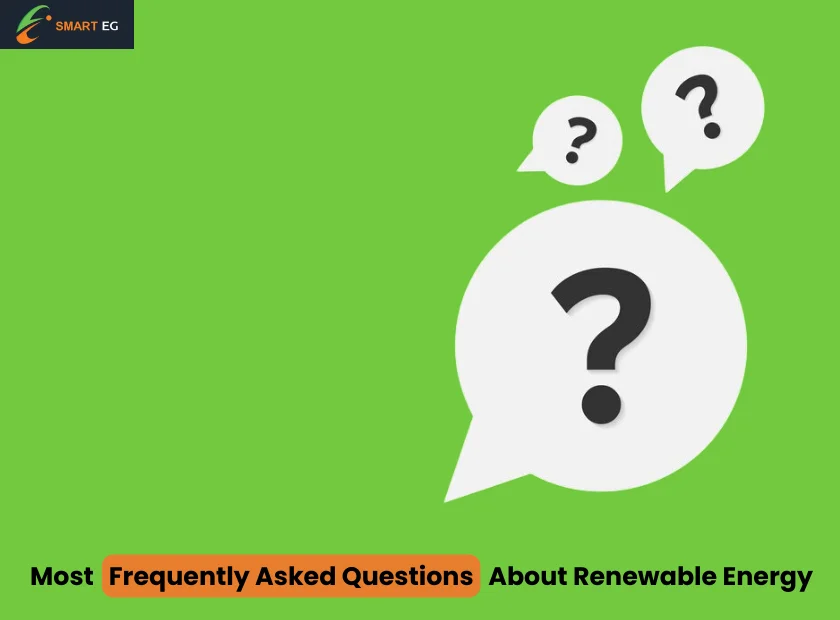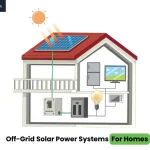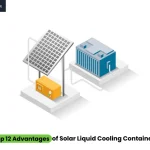Most Frequently Asked Questions About Renewable Energy

Following are the most frequently asked questions about renewable energy. Let’s find their answers!
What is Renewable Energy?
Renewable energy is the one that is derived from naturally occurring and replenishable sources such sunlight, wind, water, geothermal heat, and biomass. These sources, unlike fossil fuels, are sustainable and do not deplete with time, making them an environmentally beneficial and long-term answer for power generation.
Is Solar Energy Renewable?
Yes, solar energy is a renewable energy source. It is generated by converting sunlight into electricity or heat using photovoltaic cells or solar thermal systems. Solar energy is considered a practically infinite and renewable resource since the sun is predicted to shine for billions of years.
Is Wind Energy Renewable?
Yes, Wind energy is a renewable source of energy. Wind turbines are used to harness the kinetic energy of flowing air. Wind is a natural event that will continue to exist, making wind energy a reliable and environmentally benign power source.
What Are Renewable Energy Sources?
Example of renewable energy sources include Solar, wind, hydro (water), geothermal (Earth heat), and biomass (organic materials such as wood or crops). These sources are plentiful and naturally replenish themselves, lessening environmental consequences when compared to non-renewable choices.
What is Non-renewable Energy?
Nonrenewable energy sources like coal, oil, and natural gas are finite and will ultimately run out. When these sources are consumed, they emit greenhouse gases, which contribute to environmental challenges such as climate change.
Is Renewable Energy Cheaper?
Thanks to technical improvements and falling costs of solar panels, wind turbines, and other renewable infrastructure, renewable energy has become more cost-competitive with non-renewable sources in many circumstances. It may be less expensive in the long run, especially when considering the long-term environmental and health advantages.
What is the Best Renewable Energy Source?
The “best” renewable energy source is determined by regional, environmental, and economic considerations. Among the most popular options are solar, wind, and hydropower. The best energy source varies according on area and unique energy requirements.
Can Renewable Energy Replace Fossil Fuels?
While it will be difficult to completely replace fossil fuels in the short term, renewable energy can play an important role in reducing our reliance on this energy source, which is hazardous for the environment and human health alike. A shift to renewable energy sources is critical for addressing climate change and guaranteeing long-term energy sustainability.
Are Renewable Energy Sources Reliable?
The dependability of renewable energy sources varies according on location and weather conditions. Although solar and wind energy are inherently intermittent, developments in energy storage and grid management have increased their reliability. Hydro and geothermal energy sources are more reliable.
How Does Renewable Energy Work?
Renewable energy systems extract energy from renewable sources. Solar panels, for example, absorb sunlight and turn it into electricity, wind turbines create power from wind kinetic energy, and hydropower stations generate electricity from flowing water.
Why Don’t We Use More Renewable Energy?
The move to renewable energy is fraught with challenges, including high initial investment costs, the need for robust infrastructure development, and intermittent troubles with some energy sources. Further complicating the matters is the fossil fuel industry, which stands to lose its money and power to renewables, and therefore exercises tremendous influence in politics and economics to roadblock the transition to renewables.
Is Renewable Energy Sustainable?
Yes, renewable energy is sustainable since it is based on natural sources that are constantly renewed. Renewable energy can provide a consistent and ecologically responsible power supply as long as these sources exist.
What Form of Renewable Energy Has Declined in Recent Years?
Hydropower expansion has halted in certain areas due to environmental concerns and concerns of loss of habitats for human and animal communities alike. Also, turbocharged dam building in the past means there is now a lack of appropriate locations for building newer ones. Further complicating the matter is the fact most rivers in the world are shared by multiple countries, who are all vehemently opposed to sharing that resource with each other.
Why Don’t We Use More Renewable Energy Sources?
Renewable energy adoption is hampered by issues such as infrastructure costs, energy storage restrictions, and opposition from entrenched and highly-influential fossil fuel companies. Government regulations, public awareness, and technology developments will all be critical in hastening the move to renewables.
How Does Renewable Energy Help the Environment?
Renewable energy greatly aids the environment by lowering greenhouse gas emissions and air pollution caused by the combustion of fossil fuels. It also reduces habitat degradation and water use, contributing to a cleaner, more sustainable globe and combating climate change.
What Are the Advantages of Renewable Energy?
Renewable energy has various advantages. They are environmentally beneficial, emitting less greenhouse gases and lowering air pollution. They are also long-term energy security since they do not diminish over time. Furthermore, renewable energy may assist to create jobs, reduce reliance on fossil fuels, and stabilize energy costs.
What is the Difference Between Renewable and Nonrenewable Energy?
The main difference is their availability and environmental effect. Renewable energy sources such as wind, solar, and hydro are replenished naturally and have a lesser environmental impact. Nonrenewable energy sources, such as coal, oil, and natural gas, have finite reserves that deplete over time, leading to pollution and climate change.
What Percentage of Us Energy That is Renewable?
As of early 2023, Renewable energy accounted for around 25.11% of all electricity generated in the United States as per a report by the US Energy Information Administration (EIA). This percentage has progressively increased as wind, solar, and other renewable technologies have grown in popularity.
Why Should We Use Renewable Energy?
Renewable energy is important for various reasons. It reduces greenhouse gas emissions, increases energy security by diversifying energy sources, creates employment, improves air quality, and promotes sustainability, all of which contribute to a cleaner and healthier earth.
Is Solar Energy a Renewable or Non-renewable Resource?
Solar energy is a renewable source of energy. It is derived from the sun’s radiation and is used to create electricity and heat using photovoltaic cells or solar thermal systems. Solar energy is a plentiful and environmentally friendly source of electricity.
What Are the Types of Renewable Energy?
Solar power, wind energy, hydropower, geothermal energy, and biomass are all examples of renewable energy sources. Each has its own manner of harnessing and using such energy, which contributes to a diversified energy catalog.
How Does Renewable Energy Save Money?
In the long term, renewable energy can save money. Initial investments in technology such as solar panels or wind turbines can result in lower power costs and, in certain situations, revenue from excess energy sales. Furthermore, it protects against shifting fossil fuel prices.
What Makes an Energy Source Renewable?
When an energy source is considered to be renewable, it is renewed naturally over a relatively short duration, often within a human lifetime. Renewable resources, such as wind, sunshine, and flowing water, are always available and never decrease.
What Are the Cons of Renewable Energy?
Despite their benefits, renewable energy sources have some noticeable drawbacks as well. They can be irregular in nature, relying on factors such as weather conditions (solar power) wind patterns (wind energy) and the like. Initial setup costs for renewable infrastructure can also be very high, and there may be environmental impacts, such as habitat disruption for hydropower.
What Country Uses the Most Renewable Energy?
As of 2023, nations such as Iceland (86% of total energy production from renewable sources) and Norway (71% of total energy output from renewable sources) were leaders in the use of renewable energy, notably hydropower and geothermal sources. However, several other countries are working hard on increasing their renewable energy usage in order to reduce their carbon footprint.
Why is Renewable Energy Better Than Fossil Fuels?
Renewable energy is preferable to fossil fuels because it lowers greenhouse gas emissions, therefore slowing climate change. It is environmentally friendly, reduces air pollution, and improves energy security. Transitioning to renewable energy also promotes innovation and the creation of green employment.
Why is Renewable Energy Use Growing?
Environmental concerns, technological advancements, and economic incentives are driving the expansion of renewable energy. Government laws and incentives, as well as increased public awareness of climate change, have all contributed significantly to this expansion.
How to Make Renewable Energy at Home?
Installing solar panels, wind turbines, or small hydropower systems can help homeowners generate sustainable energy. These create clean electricity and are frequently grid-connected, allowing extra power to be sold back to utilities.
What is the Fastest Growing Renewable Energy Source?
Solar energy is one of the fastest-growing renewable energy sources. This expansion is the result of falling solar panel costs, government incentives, and the improving affordability and efficiency of solar technology.
Which Renewable Energy Source is the Best?
The “best” renewable energy source is determined by a variety of criteria, including geography, available resources, and specific goals. Because of their vast application, low environmental effect, and decreasing costs, solar and wind energy are widely regarded as among the finest. However, the options vary by location.
Why is It Difficult to Stop Using Non-renewable Energy?
It is very challenging to transition away from nonrenewable energy because fossil fuels are heavily embedded in our infrastructure and economy. Transitioning to renewable energy necessitates large expenditures, regulatory changes, and overcoming the fossil fuel industry’s vested interests.
Why Renewable Energy is Important?
Renewable energy is critical for a variety of reasons, including lowering greenhouse gas emissions, combatting climate change, improving energy security, and developing long-term, clean power supplies.
Does Renewable Energy Cost More?
Renewable energy has become increasingly affordable in recent years, making it more competitive with nonrenewable sources. The cost can be influenced by factors such as geography, technology, and local legislation. Renewable energy can become more cost-effective over time owing to decreasing operating and maintenance expenses.
Who Invented Renewable Energy?
Renewable energy has been harnessed in many forms for ages, so there is no singular inventor of this source of energy. Over time, individuals and civilizations have invented and improved renewable energy technology.
Who Issues Renewable Energy Certificates?
Renewable energy certificates (RECs) are often provided by government agencies, independent groups, or utilities to validate renewable energy generation and use. These certificates aid in the promotion of clean energy and are frequently used in regulated and voluntary renewable energy markets.
Are All Alternative Energy Sources Renewable?
Not all alternative energy sources are renewable. Alternative energy is a broad category which includes non-renewable sources such as nuclear power and natural gas, as well as renewable energy sources.
Are Renewable Energy Sources Sustainable?
Renewable energy sources are often regarded as sustainable since they do not deplete over time, emit less emissions, and have a smaller environmental effect than nonrenewable energy sources.
Does Renewable Energy Reduce Carbon Footprint?
Yes, renewable energy decreases carbon footprints greatly since it creates little to no greenhouse gas emissions during energy generation. Transitioning to renewable energy is a critical method for combating climate change.
Does Renewable Energy Save Money?
Renewable energy can save money in the long run by lowering energy bills and offering stable rates. While the initial investment may be larger, it is frequently offset by lower operational expenses and possible incentives.
How Can Businesses Use Renewable Energy?
Renewable energy may be used by businesses through installing solar panels, wind turbines, or purchasing clean energy from utilities. This lessens their environmental effect and, in certain situations, saves money.
How Can We Use Renewable Energy at Home?
To use renewable energy at home, people can install solar panels, wind turbines, or take advantage of utility green energy prices. Energy-saving products and practices also help to reduce residential energy usage.
How Do Renewable Energy Certificates Work?
Renewable energy certificates prove the generation of a certain amount of renewable energy. Each megawatt-hour generated by a renewable energy producer earns them RECs. These certificates can then put up on sale in the open market, where interested parties can purchase them as any other commodity.
How Do Renewable Energy Tax Credits Work?
Renewable energy tax credits are financial incentives offered by governments to stimulate renewable energy adoption. They often minimize the cost of installing renewable energy devices, such as solar panels or wind turbines, by providing households and companies with tax breaks or credits.
How is Renewable Energy Stored?
Renowned methods for storing renewable energy include batteries, pumped hydro storage, compressed air energy storage, and thermal storage. Excess energy may be stored and used as needed, guaranteeing a steady power supply.
How Long Will It Take to Switch to Renewable Energy?
The shift to renewable energy differs by location and is influenced by a variety of factors such as government policy, technical breakthroughs, and popular acceptance. A complete worldwide transition to renewable energy might take decades, with some regions accomplishing it faster than others.
How Much Energy is Renewable in the World?
As of early 2023, renewable energy’s percentage of total global energy output has been gradually growing. Renewable capacity is set to soar more than 100 GW to a total of almost 440 GW, roughly 18% of the global energy output. This percentage is projected to rise further as investments in renewable energy projects continue.
Is Clean Energy the Same as Renewable Energy?
Renewable energy and clean energy are somewhat similar, but definitely not synonymous. Clean energy is a larger category that covers renewable sources such as wind and solar power as well as low-emission technologies such as nuclear power and natural gas with carbon capture. Renewable energy especially refers to naturally renewed sources.
Is the Renewable Energy Industry Growing?
Yes, the renewable energy business has grown significantly. Technology advancements, lower costs, and more public awareness of environmental issues have resulted in a considerable development of the renewable energy sector, which includes wind, solar, and hydroelectric power.
What Are Problems With Renewable Energy?
Renewable energy challenges include intermittent supply (reliability), energy storage, high initial costs, land utilization, and environmental problems associated with large-scale installations. To guarantee the effective integration of renewable energy sources into energy systems, these difficulties necessitate constant study and innovation.
What Are the Limitations of Renewable Energy Sources?
Renewable energy sources have limitations such as their reliance on certain geographic circumstances such as wind or sunshine availability, as well as the necessity for effective energy storage options. Furthermore, renewable energy may necessitate significant infrastructural expenditures and, in certain situations, may have negative environmental consequences.
What is Another Term for Renewable Energy?
Renewable energy is sometimes known as “sustainable energy.” Both words relate to ecologically benign energy sources that do not degrade natural resources and may be used eternally since they are naturally regenerated. Sustainable energy stresses energy generating systems that are long-term viable and have a low environmental effect.

